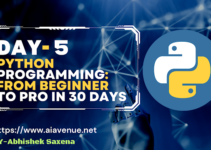Day 6: Functions – Part 1
Table of Contents:
- What are functions?
- Function definition and invocation
- Function arguments
- Return values
- Conclusion
- What are functions?
Functions are a fundamental concept in programming that allow you to break down complex tasks into smaller, more manageable pieces. A function is a block of code that performs a specific task and can be called from anywhere in your code. Functions can take one or more parameters as input and return a value as output. In Python, functions are defined using the keyword “def” followed by the function name and parentheses.
- Function definition and invocation
To define a function in Python, use the following syntax:
The function name can be anything you choose, but it should be descriptive of the task that the function performs. The parameters are optional and can be used to pass data into the function.
To invoke a function, simply use the function name followed by parentheses and any required arguments, like this:
- Function arguments
Functions can take one or more arguments, which are variables that are passed into the function and used in its execution. In Python, arguments are specified inside the parentheses following the function name. Here is an example of a function that takes two arguments:
In this case, the function takes two arguments, “x” and “y”, multiplies them together, and returns the result.
To invoke this function and pass in the arguments, use the following syntax:
Here, we pass in the values 2 and 3 for “x” and “y”, respectively, and store the result in the variable “result”.
- Return values
Functions can also return one or more values using the “return” keyword. In the previous example, the “multiply_numbers” function returns a single value, but it is also possible to return multiple values separated by commas.
Here is an example of a function that returns both the square and cube of a given number:
To invoke this function and store the returned values, use multiple variables separated by commas:
In this case, we invoke the “powers” function with the argument 3, which returns both the square and cube of 3. We then store each value in a separate variable using the comma-separated syntax.
- Conclusion
Functions are one of the most powerful tools in programming that can help you to write efficient and organized code. In a programming context, a function is a block of code that performs a specific task and can be reused throughout a program. Functions take input values, called arguments, and produce output values, allowing for complex tasks to be broken down into smaller, more manageable pieces.
In this article, we have covered the basics of functions, including how to define and invoke them, as well as how to pass arguments and return values. Defining a function involves using the “def” keyword, followed by the function name, any necessary arguments in parentheses, and a colon. The code block that makes up the function body is then indented under the function definition.
Once you have defined a function, you can invoke it by simply calling its name, followed by any necessary arguments in parentheses. When a function is called, its code block is executed, and any output is returned to the caller. Functions can also be nested, meaning that one function can be defined inside another.
One of the most significant benefits of using functions in your code is that they allow you to write modular code. This means that rather than writing a long and complicated program all at once, you can break it down into smaller, more manageable functions that each perform a specific task. This makes the code easier to understand and maintain, as each function can be tested and debugged independently of the others.
Another benefit of functions is that they can reduce code duplication. If you have several lines of code that perform a specific task in your program, you can create a function that encapsulates that task and call it wherever it is needed. This reduces the amount of code you need to write and makes it easier to make changes to that code later on.
In conclusion, functions are a powerful tool in programming that can make your code more modular, easier to understand, and easier to maintain. By breaking down complex tasks into smaller, more manageable pieces, you can write better code that is more efficient and effective. So start using functions in your code today and take your programming skills to the next level!
- Python Programming: – Day 5: Control Flow Statements
- Python Programming: – Day 4: Data Types and Variables
- Python Programming: – Day 3: Basic Concepts and Operations
- Python Programming: – Day 2: Installing and Setting up Python
- Python Programming: – Day 1: Introduction to Python








